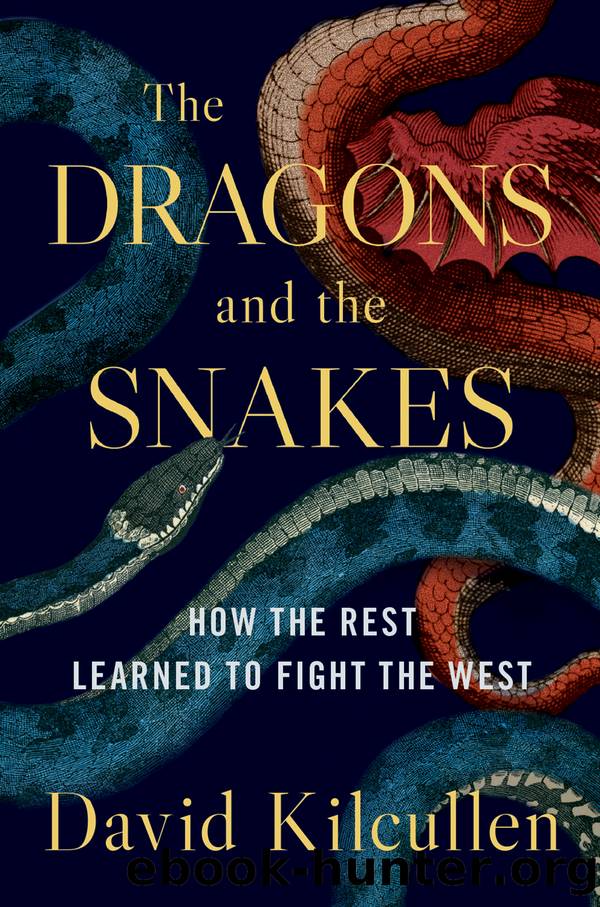The Dragons and the Snakes by David Kilcullen

Author:David Kilcullen
Language: eng
Format: epub
Publisher: Oxford University Press
Published: 2020-07-15T00:00:00+00:00
Conceptual Envelopment
In this chapter, I will argue that China’s adaptive response to the external environment—the “fitness landscape,” with its combinations of traits and pressures to adapt—created by US military dominance since the Cold War has involved not just military modernization, territorial expansion, cyberwarfare, and economic-technological competition. It has also involved a widening of the very definition of warfare, to the point where Western planners now risk what I will call “conceptual envelopment,” a situation in which an adversary’s conception of war becomes so much broader than our own that two dangerous things can happen. First, that adversary may be acting in ways it considers warlike, while we with our narrower notion of warfare remain blithely unaware of the fact, so that by the time we realize we are at war, we have already lost. Second, and what is even more dangerous, we can be taking actions that we define as normal peacetime competition, while a rival with a broader concept of conflict sees these as acts of war and responds accordingly. At worst, each of us may completely misunderstand the other’s motivation, strategy, and outlook, risking lethal miscalculation.
Strategists distinguish vertical escalation (increasing intensity of action within a given location, category of competition, or environmental domain) from horizontal escalation (expanding the geography, categories, and scope of actions, with or without increasing intensity in any one location).31 In this framework, the liminal warfare we saw Russia pursuing in the preceding chapter is a vertical maneuver, a form of brinkmanship that manipulates the intensity and detectability (the vertical “signature”) of actions, seeking just enough intensity to achieve key goals but not enough to trigger a timely military response. By contrast, the Chinese approach we will explore in this chapter is a horizontal maneuver—posing a bandwidth challenge for a rival by expanding the spectrum of competition beyond that rival’s capacity to cope, generating a multitude of simultaneous small challenges that hamper its ability to respond effectively to any one action, or perhaps even to conceptualize the overall situation as warlike at all.
In this case, the danger of conceptual envelopment is that, through miscalculation or misinterpretation, we might end up unintentionally going to war with China, sliding imperceptibly into confrontation or subconsciously losing a subliminal conflict we don’t even realize we are fighting. Presumably, neither China nor the United States wants to wage war against the other. Quite apart from its massive human cost, such a conflict, even if it did not involve nuclear weapons, would destroy decades of progress toward prosperity in China, wreck the world economy, and erase Washington’s global primacy (not least because the largest foreign holder of American national debt is China, at 1.12 trillion US dollars, or 28 percent of the total, as of December 2018).32 Rather, the risk is that, in a variant on the traditional security dilemma—where countries behave in ways they themselves deem defensive but others interpret as offensive, prompting rivals to ramp up their actions until an unsought conflict occurs—conceptual envelopment could see one or both sides caught unaware by the escalatory impact of their own behavior.
Download
This site does not store any files on its server. We only index and link to content provided by other sites. Please contact the content providers to delete copyright contents if any and email us, we'll remove relevant links or contents immediately.
| Arms Control | Diplomacy |
| Security | Trades & Tariffs |
| Treaties | African |
| Asian | Australian & Oceanian |
| Canadian | Caribbean & Latin American |
| European | Middle Eastern |
| Russian & Former Soviet Union |
The Secret History by Donna Tartt(16622)
The Social Justice Warrior Handbook by Lisa De Pasquale(11489)
Thirteen Reasons Why by Jay Asher(7788)
This Is How You Lose Her by Junot Diaz(5770)
Weapons of Math Destruction by Cathy O'Neil(5036)
Zero to One by Peter Thiel(4824)
The Myth of the Strong Leader by Archie Brown(4789)
Promise Me, Dad by Joe Biden(4447)
Beartown by Fredrik Backman(4415)
Stone's Rules by Roger Stone(4415)
How Democracies Die by Steven Levitsky & Daniel Ziblatt(4398)
The Fire Next Time by James Baldwin(4342)
100 Deadly Skills by Clint Emerson(4076)
A Higher Loyalty: Truth, Lies, and Leadership by James Comey(4032)
Rise and Kill First by Ronen Bergman(4012)
The David Icke Guide to the Global Conspiracy (and how to end it) by David Icke(3881)
The Farm by Tom Rob Smith(3872)
Secrecy World by Jake Bernstein(3782)
The Doomsday Machine by Daniel Ellsberg(3730)
